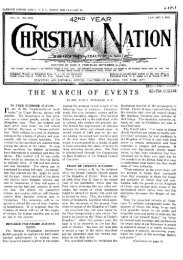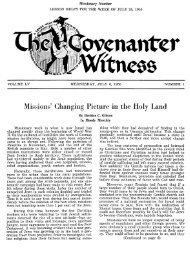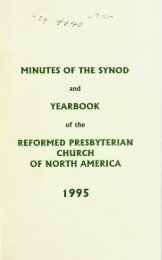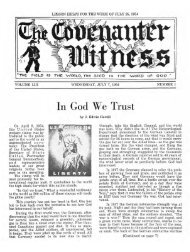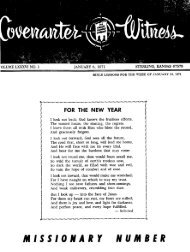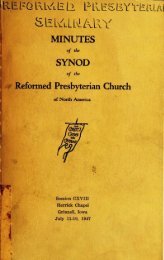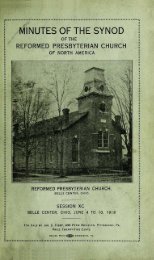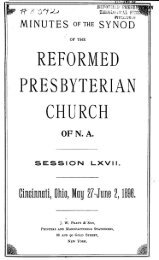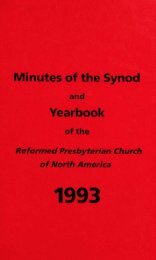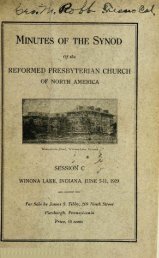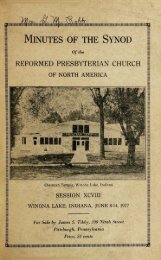S C R I B N E R ' S M A G A Z I N E Important ... - Rparchives.org
S C R I B N E R ' S M A G A Z I N E Important ... - Rparchives.org
S C R I B N E R ' S M A G A Z I N E Important ... - Rparchives.org
You also want an ePaper? Increase the reach of your titles
YUMPU automatically turns print PDFs into web optimized ePapers that Google loves.
December 17, 1913.<br />
A FAMILY PAPER.<br />
E D I T O R I A L<br />
John W. Pritchard, Editor.<br />
ORGANIC CHURCH UNITY.<br />
Practically all denominations of Christians aro<br />
ready for <strong>org</strong>anic church unity. The difficulty<br />
seems to be to arrive at an acceptable basis of<br />
unity, that is a basis acceptable to all. Each denomination<br />
is quite able to propose a basis acceptable<br />
to itself, and though the proposed basis<br />
is different in each instance, there is a striking<br />
similarity between them all. A wily Roman<br />
CathoUc said; "Sure, it's an easy task, this of<br />
uniting the churches. Just let them all acknowledge<br />
his holiness, the Pope, and the thing's<br />
done." The latest basis is that proposed by the<br />
Rev. J. M. Foster.' The basis he proposes has<br />
the family likeness of many such proposals in<br />
that it is but a restatement of the principles<br />
for which our own Church stands. Mr. Poster<br />
builds a platform of eight planks; 1. An acceptance<br />
of the Scriptures of the Old and New<br />
Testaments as the word of God and the only<br />
rule of faith and practice. 2. An acceptance of the<br />
Confession of Faith and Catechisms, larger and<br />
shorter, of the Westminster Assembly, as agreeable<br />
unto and founded upon the Scriptures. 3.<br />
An acceptance of one unalterable form of Presbyterian<br />
church government. 4. An acceptance<br />
ot the manner of worship prescribed in the holy<br />
scriptures. 5. An acceptance of public social<br />
covenanting as an ordinance of God lor churches<br />
and nations. 6. An acceptance of the offlce of<br />
witness for Christ. 7. An acceptance of the<br />
separated life. 8. An acceptance of the obedient<br />
lite." This is the latest, and we must confess,<br />
in our judgment, the most satisfactory basis of<br />
union yet proposed. Its great excellence will appear<br />
to any thoughtful student of the Westminster<br />
Standards and Covenanter literature.<br />
DR. MARIA MONTESSORI.<br />
Mme. Maria Montessori, ol Rome, is in America<br />
for thirty days, to tell of her method of training<br />
the child mind that has interested every part of<br />
the world where children are taught. Her system<br />
is one of self-development. She creates an<br />
atmosphere, introduces the child ol three to eight<br />
into it, and leads them- to see things with their<br />
fingers. She teaches the diiference between hot<br />
and cold hy having the children wash their hands<br />
in cold water and suddenly dip them in warm.<br />
Then she has them pass their fingers over the<br />
rough and smooth surface of letters or other<br />
material until they know the difference between<br />
Rough and Smooth. Thus she uses the inductive<br />
method with children by giving them experienca<br />
with concrete things. The children become so<br />
interested in getting acquainted with things and<br />
doing things, that they are filled with pleasure.<br />
There is no need of punishment because the<br />
children are happily employed in things that<br />
eac'a one can do and loves to do. Sometimes<br />
they may need restraining from things that encroach<br />
on their neighbors. "Certainly," she says,<br />
"they must never be beaten." She believes in<br />
•Christ's method of love. The teacher, she insists,<br />
must not use force, but must quietly study<br />
the child, and merely help It to find itself. It<br />
is a passive, not an active guidance which the<br />
teacher is to exercise. If all this is so applicable<br />
to the primary, how truly essential it becomes<br />
tor every home and every father and mother.<br />
High and low, thick and thin, round and ovalare<br />
taught in the way described. All abstract<br />
ideas are gained directly from concrete experiences<br />
in games with blocks, cylinders, discs,<br />
stones, and the familiar furniture of the home.<br />
They are taught to sweep the floor,set the table.<br />
wash the dishes, black their boots and shoes, and<br />
keep things clean and orderly. Games of identifying<br />
words with their objects lead to reading,<br />
and the knowledge that may be gained from<br />
books. Counting games lead to arithmetic.<br />
Children of three and four years of age thus<br />
learn to read and write in different languages<br />
and are not conscious of weariness. By means<br />
of the moving pictures which Mme. iMontessori<br />
uses to illustrate her lecture, we saw little<br />
children at the blackboard writing, and doing so<br />
letter than the vast majority of grown ups can.<br />
Those are the most ideal homes and schools<br />
where the parents are using the iMontessori system<br />
unconsciously.<br />
If we were permitted an opinion on this method,<br />
after hearing the lectures of Mme. Montessori<br />
and seeing the actual work and results of the<br />
system, we would say it is not a lad or a mystery,<br />
but love getting a chance with the children<br />
and leading them up to the noblest things. Mme.<br />
Montessori says that children are naturally religious,<br />
and that it is amazing what they can be<br />
taught, by her system, ol religion, morality,<br />
beauty, order, individuality and freedom.<br />
Great things are expected ol this system, as it<br />
carries its truths into the homes, quickening<br />
them, regenerating them, and transforming<br />
whole neighborhoods as it has done in Rome.<br />
The future men and women trained in this way<br />
promise purer, stronger, healthier and more efflcient<br />
lives. Why shall we not hope that love<br />
shall have its place in the uplift of the world'?<br />
The place to begin is with the children and the<br />
home.<br />
What a change would come over society if this<br />
method were introduced into schools and homes<br />
generally.<br />
NO NATIONAL MASS.<br />
Protestants had expected that the President's<br />
attendance at Mass on Thanksgiving would<br />
cease with Mr. Taft the Unitarian. So when it<br />
was given out that President Woodrow Wilson<br />
had accepted the Papal invitation lor 1913, the<br />
Lutheran, the Episcopalian, and the Disciples' pastors<br />
ol Washington protested, but without avail;<br />
and as we published, the President and also the<br />
Secretary ol State, both Presbyterian Elders,<br />
attended the Mass. We take the lollowing trom<br />
'The Presbyterian," ol December 3;<br />
Anti-Roman Protest of the Clergy of Washington,<br />
D. C.<br />
The Pastors' Federation ol Washington, D. C,<br />
and other <strong>org</strong>anizations, on November 24, passed<br />
the lollowing resolutions:<br />
"For the last three or lour years, there has<br />
been celebrated in St. Patrick's church, Washington<br />
on Thanksgiving Day, a solemn high mass,<br />
at which the President of the United States and<br />
some members of his Cabinet, the Chief Justice<br />
and several other Justices of the Supreme Court,<br />
with a number of senators and members of Congress<br />
have attended as the guests of honor.<br />
"This service is now called in the public press<br />
'the official celebration of Thanksgiving Day,'<br />
and is described ini the bulletin of the Pan-<br />
American Republics as having an 'official' character<br />
and every effort is made .by the Roman<br />
hierarchy to give this Roman mass the coIor.,ol<br />
an offlcial function-as il it were generally recognized<br />
as a national service, and as If the President<br />
and his Cabinet by their presence wished it<br />
to be so recognized (which we are sure is not<br />
the case). ^ 4.,, ,-<br />
"One ol the <strong>org</strong>ans ol the Roman Catholm<br />
press (the 'Catholic Citizen' of Milwaukee) states<br />
that 'the Pan-American Thanksgiving Day high<br />
mass is now a permanent institution at the National<br />
Capital'; and says further; 'One day in the<br />
year in which the Bountiful Giver of all good<br />
things is acknowledged by the nation, as a nation—this<br />
expression of gratitude is made in a<br />
Catholic church, around a Catholic altar, by<br />
means ol the one Catholic worship that is worthy<br />
of God, the sacrifice ol the mass.'<br />
"The attendance ol our Chief Magistrate and<br />
members of his Cabinet not once, but year after<br />
year, lor three or lour years, has been made<br />
use of to give color to the Roman claim that<br />
this service is now the ofiicial celebration ol<br />
Thanksgiving Day in our National Capital.<br />
"This fact has been understood, both in the<br />
United -States and in foreign countries, to give<br />
the Roman Catholic Church a prestige and a<br />
prominence over all other Churches, and has<br />
even been believed by people in Brazil and Italy<br />
to show that America is not a Protestant but a<br />
Roman Catholic country."<br />
"It was resolved;<br />
"That we protest against the presumption of<br />
the Roman Catholic press in putting forward the<br />
claim that the Roman mass is the ofiicial celebration<br />
of Thanksgiving Day in the capital of<br />
the republic.<br />
"That we protest against the attempt to convert<br />
our national Thanksgiving Day into a<br />
Roman Catholic lestival, in a service entirely<br />
out ol harmony with the history ol the genius<br />
of our country, and the spirit and purpose ol<br />
the day.<br />
"That we desire to give voice to the widespread<br />
leeling ol indignation among the millions<br />
ol Protestants in America against the efforts of<br />
the Roman press and the Roman hierarchy to<br />
exploit the attendance ol our Chiel Magistrate<br />
and some ol his Cabinet (which we are convinced<br />
has only been intended as an act of courtesy<br />
and good will) for the purpose of glorifying the<br />
Roman Catholic Church and giving this service<br />
an official charcater, which it does not and cannot<br />
possess."<br />
The Roman priests at Washington have criticized<br />
the action of the Protestant ministers, but<br />
without reason, lor some ol the Roman Catholic<br />
papers in our own country have interpreted the<br />
Washinston Thanksgiving Day mass as an official<br />
celebration, an example ol which is the<br />
citat;on_ given above from "The Catholic Citizen"<br />
of Milwaukee. It is just such things as<br />
this that have aroused new antagonism to<br />
Romaniem among American people, and have called<br />
forth the publication of the <strong>org</strong>an known as<br />
"The Menace," and caused the revival of the A.<br />
P. A. The President and Secretary of State might<br />
have guarded against endorsing this growing<br />
custom, which thus flaunts the red flag in the<br />
face of many citizens, and contributes inflammable<br />
material to this already kindled flre.<br />
These men are perfectly free to go to a Catholic<br />
service anywhere and at any time; but when<br />
this becomes a concertive act, and the circumstances<br />
are likely to produce misunderstanding,<br />
wisdom alone would suggest that in such case<br />
they repair for the service ol God in their respectice<br />
places ol worship.<br />
THE NATIONAL REFORM CONVENTION.<br />
The annual meeting ol the National Reform Association<br />
was held at Pittsburgh, Pa., on Tuesday<br />
morning, December 2, 1913. In connection with<br />
it, a Christian Citizenship Conference was held<br />
on the day belore and on the same day. This<br />
was patterned alter the Portland Conierence ol<br />
last Summer, and was well attended, even with<br />
unlavorable weather. The Sectional Conlerences<br />
of Monday and Tuesday afternoons were held in<br />
the First and the Second Presbyterian churches.<br />
The annual Association meeting ol Tuesday morning<br />
was held in the Eighth Street Reformed



